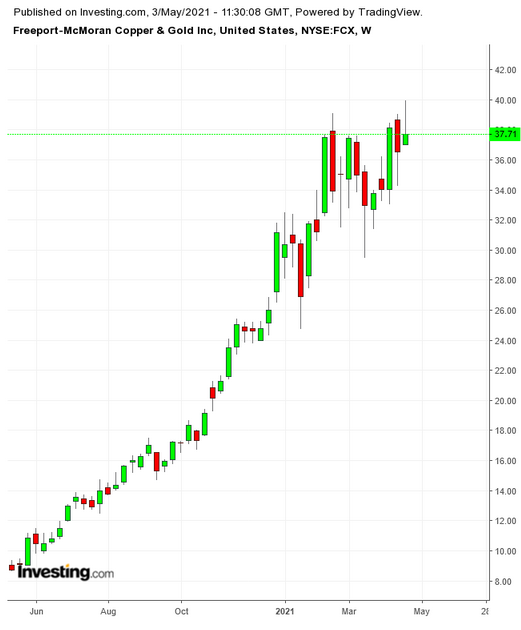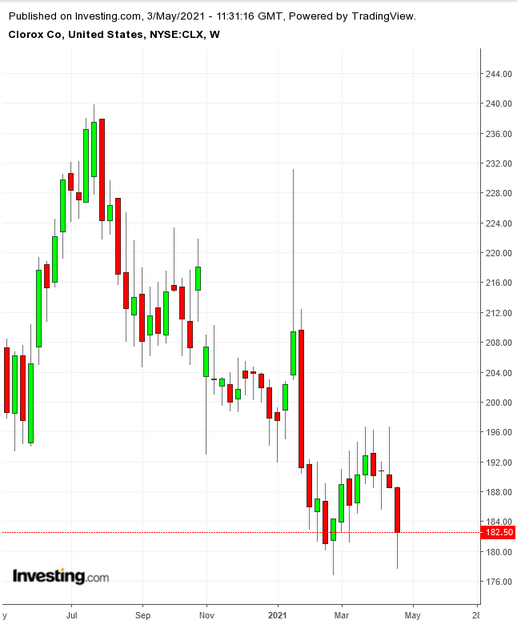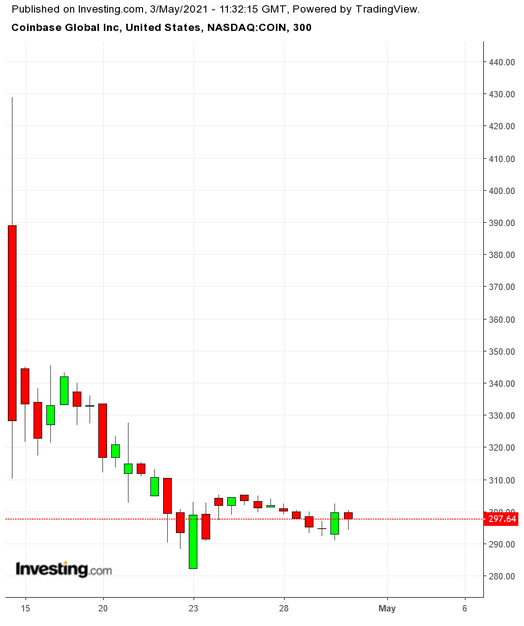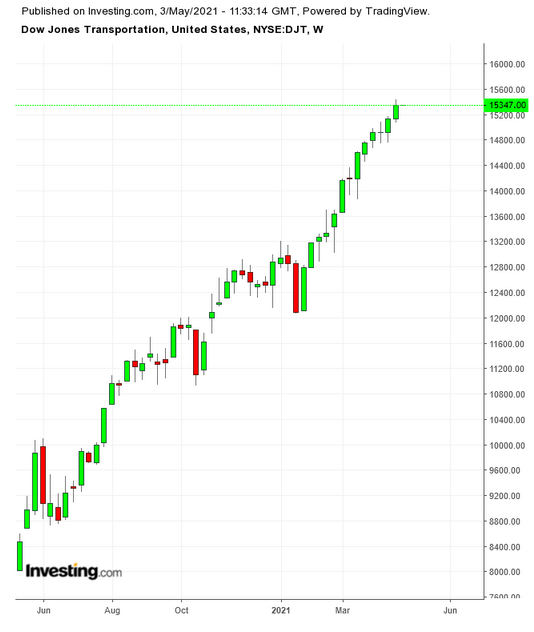The U.S. stock market doesn't want to go down, and there's not much—yet—that can stall the rally that erupted a year ago as investors saw an imminent economic recovery.
The S&P 500 had its best month of 2021 thus far this year in April and its best performance since December. The NASDAQ Composite and NASDAQ 100 indices enjoyed their best months since November.
The biggest reason stocks have continued to move higher, of course, is the Federal Reserve, whose policy makers do not see the central bank raising interest rates until at least late next year or early 2023.
Plus, first quarter earnings have been coming in better than expected with the most strength in technology and communications stocks and consumer stocks like home builders.
In addition, the Biden Administration is aggressively trying to boost spending and create jobs across the country. Whether the President gets all he wants depends, of course, on Congress.
Still, risks lurk in the economic and investment background, including the general market euphoria, materials and semiconductor shortages and inflation worries.
Robust Earnings, Improved Data Fuel Gains
The S&P 500 finished April up 5.2% for the month; it's up 11.3% for the year. The NASDAQ was up 5.4%, its best month since November and up 8.3% year-to-date. The NASDAQ 100 had been up nearly 7.3% in mid-April before sliding back to 5.9% for the month. It's up 7.6% YTD.
The Dow Jones Industrials had a more measured month, up 2.71%, after a 6.6% gain in March. Still, the blue chips are up 10.7% for the year.
In theory, but only in theory, annualizing the returns for the first four months of 2021 might produce returns in excess of 27% and then some, depending on the index. But that's just conjecture right now on our part.
Helping the indexes, if not every stock, was the expectation that first quarter earnings reports as well as improved economic data would fuel the market's gains, which thus far has indeed been the case.
This coming week Pfizer (NYSE:PFE), Moderna (NASDAQ:MRNA), PayPal (NASDAQ:PYPL), Booking Holdings (NASDAQ:BKNG), Hilton Worldwide (NYSE:HLT), ConocoPhillips (NYSE:COP) and General Motors (NYSE:GM) report, likely adding to the picture.
What Powered Markets In April
Leading the S&P 500 higher were the Real Estate, Communications Services and Consumer Discretionary sectors and companies that produce industrial commodities needed in an economic recovery.

Freeport-McMoRan (NYSE:FCX), one of the largest copper producers, was up 14.5% for the month and 45% on the year.
Copper finished April up 11.8% at $4.468 a pound and is up 27% on the year. The U.S. Copper Index Fund (NYSE:CPER), an ETF that tracks copper, added 11.4% in April and is up 26.2% for the year.
That, of course, makes complete sense: the recovery should bolster demand for real estate, especially for apartments, warehouses and other commercial spaces which have already been hot since the start of the pandemic. The communications services sector includes Google parent Alphabet (NASDAQ:GOOGL and (NASDAQ:GOOG), Facebook (NASDAQ:FB), Disney (NYSE:DIS), Fox Corp. (NASDAQ:FOX) and (NASDAQ:FOXA), AT&T (NYSE:T) and Netflix (NASDAQ:NFLX).
Consumer discretionary stocks include Amazon.com (NASDAQ:AMZN) (up 12.1% in April after struggling in the first quarter), Home Depot (NYSE:HD) (up 6%), Target (NYSE:TGT), Nike (NYSE:NKE), down 0.2% in April, and Starbucks (NASDAQ:SBUX), up 4.8%, Amazon has been a huge winner from the pandemic, rising 76% in 2020 and has the third-largest market cap of any U.S. company after Apple (NASDAQ:AAPL), Microsoft (NASDAQ:MSFT) and Alphabet.
Laggards included semiconductor stocks, hit by materials shortages, Industrials and Consumer Staples) (think Wal-Mart (NYSE:WMT), Kroger (NYSE:KR).
One group that seems to have weakened: Stocks that rallied because the companies were able to capitalize on millions of Americans in quarantine.
These include Clorox (NYSE:CLX), an investor darling at the beginning of the pandemic.

Clorox was up 31% in 2020 but, after a 5.4% decline in April, is down 9.6% this year. Also lower: eBay (NASDAQ:EBAY), down 8.9% for the month and exercise equipment company Peloton (NASDAQ:PTON), down 12.5% for the month.
Energy companies appeared to lag the overall market even as oil prices moved solidly above $60 a barrel. Chevron (NYSE:CVX) was down 1.6% in April but is still up 22% for the year.
Coinbase Global (NASDAQ:COIN), which provides the infrastructure and technology for cryptocurrencies, started trading at $381 during April, zoomed up to $429.54 on the day of its debut in the public markets, then immediately fell back after that.

It ended the month at $297.64, down nearly 22%.
Still, none of the 11 S&P 500 sectors were negative for the month.
Transports Were Clear Winners
Pay attention to the Dow Jones Transportation Average (DJT). It has accelerated for 13 straight weeks. This is a most unusual streak.

The Wall Street Journal noted the current run is within striking distance of the record 15-week streak that ended in 1899.
Gains for the transports are clearly due to investor confidence in a strong recovery. The index rose a relatively modest 4.9% in April but is up 22.7% for the year, a performance that's better than the Dow, S&P 500 and the NASDAQ. The index closed above 15,000 for the first time on Apr. 21 and hit new closing and 52-week highs on Thursday.
The index has risen not just because investors believe people will start flying again and that the delivery business of FedEx (NYSE:FDX) and United Parcel Service (NYSE:UPS) will continue to be strong.
Railroads are surging as well. One reason is that they're moving more stuff than they were during the pandemic. U.S. rail freight traffic this year through Apr. 24 is up 9.4% from a year ago, according to the American Association of Railroads.
Equally important is the prospect that the Kansas City Southern Railway Company (NYSE:KSU), which operates from the Midwest into Mexico, is being courted by Canadian National (NYSE:CNI), with a $33.7 billion bid, and Canadian Pacific (NYSE:CP), offering $25 billion. The idea is to link Mexico, the United States and Canada via one service.
Aerospace giant Boeing (NYSE:BA), however, has not participated in the transport rally. Shares were down 8% in the month as the fallout from the 737 MAX crashes and problems with the 787 Dreamliner continued to affect investor opinions on the company. Plus, it didn't help that Delta Air Lines (NYSE:DAL) recently spurned the 737 MAX for an order of 25 Airbus (PA:AIR) 320 Neos.
Selling While The Selling Is Good
Though the market's gains were solid, there were some unsettling moments, suggesting that some investors will sell on the news regardless.
This happened to Microsoft (NASDAQ:MSFT), which easily beat earnings estimates for its fiscal third quarter on Tuesday. The shares had hit a 52-week high just ahead of the report and then sagged, ending the week with a 3.4% loss.
Amazon.com had a similar experience despite crushing estimates with its first-quarter report after Thursday's close. The shares jumped to a new high of $3,553.39 soon after the Friday open, then fell back to $3,467.42 at the close.
And Warren Buffett has come under fire because Berkshire Hathaway (NYSE:BRKa) has been a market laggard of late with returns over the last three and five years trailing the S&P 500. The shares were up 7% in April and are up 18.6% this year.
While the conditions for continued market strength going forward are strong, the risks markets face may become more pronounced.
Here are the top six:
Risk # 1: Market Euphoria
Fears remain that many people are diving into stocks because rates are low and will continue to be so, even as the economy is recovering. The investor narrative says the Fed will protect against a crash or a nasty correction of longer duration.
That thought surely entered the minds of some investors as they watched Microsoft and Amazon shares sell-off. It seems too as if the major averages have been struggling of late to hit new highs.
Risk #2: Inflation Anyone?
For the first time in a long time, tech or tech-related stocks were not the big market story for markets. It is not that tech stocks went away. Apple (NASDAQ:AAPL), Microsoft, Alphabet, Amazon and Facebook now represent 25% of the S&P 500's market capitalization. Even if their April stock performances weren't at the eye-popping levels of last year, their financial strength remains powerful.
The recovery in all its messy and uneven trajectory is what's dominating markets now. The Fed has vowed to keep rates low until it can see sustained inflation of around 2%. But prices lately have been jumping, and Fed Chairman Jerome Powell has insisted the inflation the central bank is seeing is transitory.
Some Fed critics believe the Fed's current policy is already reigniting inflationary pressures. And they are worried about the Biden Administration's stimulus plans. (Remember though, they also complained about the Fed when Ben Bernanke was the Fed boss.)
Some inflation worries are true, however. Oil prices collapsed a year ago, falling to as low as NEGATIVE $37.63 because of the panic that COVID-19 had set off. West Texas Intermediate was at about $64 a barrel as of Friday placing it a bit higher than it was before the pandemic.
And crude oil wasn't alone. Interest rates plunged at the start of the pandemic, as did prices for a variety of commodities and other products. But when the markets turned higher, investors searching for big, fast returns went to stocks because rates were and remain so low.
The 10-year Treasury yield ended April at 1.63%, down slightly from March. The yield had fallen to as low as 0.57% in April 2020 and unnerved many when the rate pushed back up to 1.76% on Mar. 30.
But prices of other products have soared. Lumber has tripled, making housing affordability even more difficult for first-time home buyers just about anywhere.
The dollar was weaker in April, especially against the Japanese yen. A weak dollar may help exports over time, but it can also push prices higher.
Risk #3: Chip Shortages
It is hard to believe that a piece of silicon smaller than a fingernail can cause huge economic worries.
But severe shortages of computer chips used in everything from mainframes to cell phones, microwaves and automobiles are disrupting business.
General Motors, Ford (NYSE:F), Tesla (NASDAQ:TSLA) and companies have had to slow down or even stop some production. Apple and Samsung (OTC:SSNLF) have warned of chip supply issues. Apple said this week the shortages could cost the company $3 billion to $4 billion in sales in the June quarter.
Risk #4: Labor Shortages
Not much has been said yet about labor shortages. Nevertheless, they're hitting a lot of industries.
Workers laid off don't want to come back or have moved. The Cass Truckload Linehaul Index, which looks at pricing trends for trucking services on a per mile basis broke a record set in 2018. Upward pressure is likely to persist because of the recovery—along with shortages of trucks and, equally important, drivers.
Risk #5: The Ongoing Pandemic
One would be foolish to believe the COVID-19 pandemic is totally behind us.
In many parts of the United States, COVID infections and hospitalizations are declining. But not everywhere.
And the big fear is what happens if vaccines from Moderna, Pfizer and Johnson & Johnson (NYSE:JNJ) can't protect against the variants now raging in India and Brazil.
Risk #6: Geopolitics
Two areas within this realm are worth watching too, since that can also affect markets.
The United States does not have a great relationship with China, in part because China wants to be the dominant player in the western Pacific region. And China wants to bring Taiwan directly under its control.
Then there's Russia. What is problematic is Putin's interest in gaining more control over Ukraine. Russia massed military personnel on the Ukrainian border in April but ultimately pulled back. The question is how Europe would react to an invasion.
